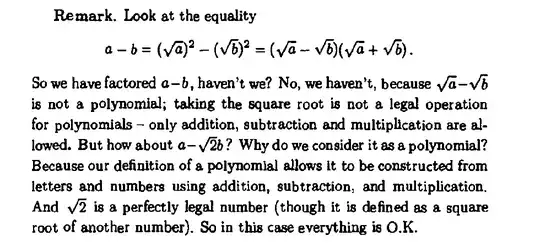I think you're missing the key notion of abstraction (sometimes aka 'formality') behind polynomials. Suppose that we say 'a polynomial (in one variable) over some base structure is formally an expression of the form $P(x)=\sum_{i=0}^{n_P} p_ix^i$, where $n_P$ is some non-negative integer (so that the notion of summing makes sense) and each $p_i$ is a 'scalar' (i.e., an element of our base structure). Then we can define an addition operation on polynomials $P(x)$ and $Q(x)$ by defining the polynomial $R(x)=\{P+Q\}(x)$ such that $n_R=\max(n_P, n_Q)$ and $r_i=p_i+q_i$ for all $i\leq n_R$ (where any potentially undefined $p_i$ or $q_i$ are taken to be zero). Note that for this definition to make sense, we need to have an addition defined on our base structure, but that's all we need for this formal definition to make sense!*
Similarly, we can formally define the product of two polynomials $P(x)$ and $Q(x)$ by defining the polynomial $R(x)=\{P\cdot Q\}(x)$ such that $n_R=n_P+n_Q$ and $r_i=\sum_{j=0}^i p_jq_{i-j}$ for all $i\leq n_R$ (again taking potentially undefined coefficients as zero). For this definition to make sense, we need to have some sort of multiplication defined on our base structure, but again that's all we need for the formal definition to make sense; as long as we have a 'base structure' with commutative addition and (not necessarily commutative!) multiplication, we can define these formal polynomial-things over that structure, and they also have (commutative) addition and a well-defined multiplication.
Now, there's also an 'evaluation map' that comes with each polynomial; if we call our base structure $B$, then for each polynomial $P(x)$ we can define a function $P^*:B\mapsto B$ by $P^*(b)=\sum_{i=0}^{n_P} p_ib^i$, where we use the multiplication in the base structure to compute the $b^i$ and then the product $p_ib^i$, and the addition in the base structure to compute the sum. This function can be very useful, but it's not the only thing we care about with polynomials; often we really only care about the polynomial as a formal entity!
We can talk about other algebraic structures than polynomials, and of course other functions. But one of the great benefits of polynomials is that all we need on the base structure is addition and multiplication, and they give us a new structure that also has addition and multiplication. For instance, I only defined polynomials in one variable above — but we can think of a polynomial in two variables $x,y$ as a polynomial in $y$ whose coefficients are each polynomials in $x$: $P(x,y)=\sum_{i=0}^{n_P}P_i(x)y^i$.
Often in mathematics, the key to abstraction is to see how small the minimal set of requirements placed on a structure can be in order to do 'interesting' things with it. The idea of a group, for instance, can be motivated by starting with the integers $\mathbb{Z}$ and noticing that the addition operation, all by itself, satisfies some interesting properties (it has an identity and it has inverses), and asking what we can say about structures where all we require is those properties, plus the basic rules we'd like them to obey. Because the requirements are so low, they can be met by things that look nothing like numbers — for instance, the set of symmetries of a dodecahedron.
Polynomials require a little more from the base structure, but the requirements are still small enough that we can apply them to all sorts of interesting structures that aren't just $\mathbb{R}$ (or $\mathbb{C}$).
$$ $$
*For simplicity's sake, we really want commutativity of addition or else we can't necessarily 'force' the ordering of the sum so that it makes sense.
